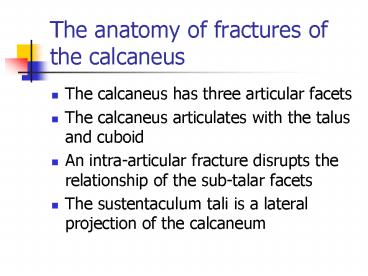The anatomy of fractures of the calcaneus - PowerPoint PPT Presentation
1 / 28
Title:
The anatomy of fractures of the calcaneus
Description:
An intra-articular fracture disrupts the relationship of the ... Articular branches to hip, motor to biceps, semitendinosus, semimembranosus and adductor magnus ... – PowerPoint PPT presentation
Number of Views:837
Avg rating:3.0/5.0
Title: The anatomy of fractures of the calcaneus
1
The anatomy of fractures of the calcaneus
- The calcaneus has three articular facets
- The calcaneus articulates with the talus and
cuboid - An intra-articular fracture disrupts the
relationship of the sub-talar facets - The sustentaculum tali is a lateral projection of
the calcaneum
2
(No Transcript)
3
(No Transcript)
4
The anatomy of the femoral artery
- Is the continuation of the external iliac artery
at the inguinal ligament - Leaves the thigh through the adductor hiatus to
become the popliteal artery - The profunda femoris artery is its only branch
- Lies lateral to the femoral nerve in the femoral
triangle
5
(No Transcript)
6
(No Transcript)
7
The anatomy of the femoral nerve
- Is a branch of the lumbar plexus derived from the
anterior divisions of L2,3 4 - Is a predominantly cutaneous nerve and the
quadriceps is the only muscle supplied - Divides into anterior and posterior divisions in
the thigh - The saphenous nerve is the major cutaneous branch
8
(No Transcript)
9
Anterior Division
- Intermediate and medial cutaneous nerves of thigh
- Nerves to Pectineus and Sartorius
10
Posterior Division
- Motor to quadriceps
- Articular branches to knee joint
- Saphenous nerve
11
The following are features of an injury to the
sciatic nerve
- Foot drop
- Weakness of quadriceps and loss of knee jerk
- Loss of sensation on the dorsum of the first web
- Loss of sensation on the medial side of the leg
12
Sciatic nerve
- Articular branches to hip, motor to biceps,
semitendinosus, semimembranosus and adductor
magnus - Tibial and Common Peroneal nerves
13
Tibial nerve
- Gastrocnemius, soleus, popliteus, plantaris
- Tib post., FHL. FDL
- Sural nerve (lateral foot)
- Medial and lateral plantar nerves
14
Common peroneal nerve
- Lateral sural cutaenous nerve
- Superficial and deep branches
- Superficial to lateral/peroneal compartment
- Deep branch to anterior compartment medial
terminal branch supplies dorsal first web
15
The compartments of the lower leg
- There are 4 compartments anterior, lateral,
deep and superficial posterior. - The posterior tibial nerve is in the lateral
compartment and supplies sensation to the sole of
the foot - The deep peroneal nerve is in the anterior
compartment and supplies sensation in the dorsal
first web - The posterior tibial nerve is in the deep
posterior compartment
16
(No Transcript)
17
The lateral ligament of the ankle
- The lateral ligament has three bands
- The anterior talofibular band runs from the
lateral malleolus to the anterolateral talus - The strongest portion of the ligament is the
posterior talofibular band - The middle band inserts into the tubercle of the
talus
18
(No Transcript)
19
The blood supply of the femoral head and neck
- Is dependant on direct branches of the gluteal
arteries - May be maintained by the artery of ligamentum
teres - The head is dependent on retinacular and
intra-osseous vessels - In adults there is significant anastomosis of
epiphyseal and metaphyseal vessels
20
(No Transcript)
21
The tibial (medial) collateral ligament of the
knee
- Can be divided into deep and superficial portions
- Has no attachment to the medial meniscus
- The superficial portion attaches to the tibia
immediately below the joint line - The deep portion blends with the capsule and the
posterior oblique ligament posteriorly
22
(No Transcript)
23
The anterior cruciate ligament
- Lies within the synovium
- It runs posteriorly, superiorly and laterally
- It has a good supply from a direct branch of the
popliteal artey - Is a restraint to anterior tibial translation and
guides the screw home mechanism of the knee
24
(No Transcript)
25
The menisci
- The menisci cover less than half of the
corresponding articular surface of the tibia - The lateral meniscus is a more open C shape and
is attached to the lateral (fibular) collateral
ligament. - Are well vascularised
- The anterior horn of the medial meniscus is wider
than the posterior
26
(No Transcript)
27
The anatomy of the talus
- The blood supply to the talus enters
predominantly through the body leaving the head
vulnerable to avascular necrosis - The neck of the talus forms the roof of the sinus
tarsi - The majority of the surface of the talus is
covered by articular cartilage - The main blood supply to the talus is from a
branch of the anterior tibial artery
28
(No Transcript)

